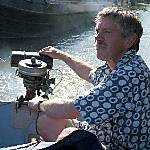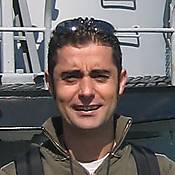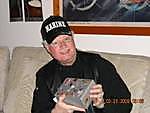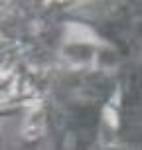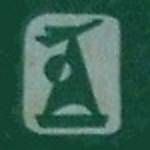You are viewing the archived version of the site.
Go to modelshipwrights.com for the current dynamic site!
Go to modelshipwrights.com for the current dynamic site!
1⁄350USS Lexington (CV2) 1927-1942
23
Comments
Flight deck life rails: the chain-link type along the starboard side outboard of the superstructure came from the GMM PE set. Chain-link life rails were added wherever else was necessary around the deck edge – principally above the 5-inch and light AA positions. Also added was a semi-circular 3-bar rail around the base of the starboard mast strut at flight deck level.
Elevator life rails: those around the aft elevator were from the GMM PE set. Since none were provided for the forward elevator, I made these up from spare 3-bar railing from the GMM PE set by removing the middle two bars and alternate stanchions.
Arrestor gear sheaves: these were from the GMM PE set. I had intended using mono filament for the arrestor wires but didn’t do this because they’re etched into the Nautilus wooden deck.
Life nets: for security and strength, I had planned to mount the GMM PE life nets around the flight deck edge on brass wire outriggers glued into drilled holes. However, a test just using superglue to fix a net to the deck edge proved that this was quite strong enough. One section of net immediately forward of the starboard bow 5-inch AA platform had to be removed because it would have interfered with the training and elevation arcs of the forward gun.
Frustratingly, there was an insufficient (and incorrectible) length of life net forward of the second boat pocket on the port side. This seemed to have something to do with differences between the moulded deck and the Nautilus version in the position of the ladder platforms down to the boat pockets. The Nautilus deck is accurate, whereas the moulded kit part is not. GMM seem to have produced their set as a straight replacement for the kit parts, not for complete accuracy, hence the dimensional error. The resulting wildly differing gaps in the netting around the boat pocket ladders was visually very disturbing, so I pulled the nets off and repositioned them at accurate spacing around the ladders. This meant accepting a shortage of netting at the forward end, but this was visually more acceptable.
Extra platforms: two platforms below the rear quarters of the flight deck (originally landing signals platforms) were made up from styrene sheet and strip. The ladders between these and the aft gallery deck were made up from parts F16 in the GMM PE set. There should also have been ladders from the platforms up to the flight deck (from parts F12) but the geometry of the model in this area made it impossible – the radius of the flight deck cutaways was too large.

Above: Additional platform and ladder on starboard quarter.
Searchlights: the fronts were drilled out to half-depth and filled with Humbrol ‘Clearfix’, a thick, transparent substance usually used for drawing across apertures to create the impression of glazing. I originally tried superglue in both thick and thin consistencies, but it didn’t work because it always dried an opaque matt grey. I found it best to paint the searchlights first, then drill out the fronts and fill them with ‘Clearfix’
Life rings: these came from the GRRM PE set, as did four short lengths of near-vertical ladder from the fight deck down to the life nets on either side abaft the stack position.
Triangular gusset between flight deck and rear of port mast strut: made from styrene strip.

Above: Completed detail around the bridge structure – compass on catwalk, gusset at foot of port mast strut and deck-edge safety rails enclosing starboard mast strut.
Deck-edge floodlights: the fork-shaped brackets were made from spare three-bar railing and the pairs of lamps from styrene rod.

Above: One of the 14 pairs of deck-edge floodlights.
Aircraft crane: The jib (B25) is rather under scale in length but doesn’t look too bad and was left as it was. On the other hand, the king post (B9) is too tall and was shortened. The hooked end of part B23 was cut off and the piece mounted horizontally instead of vertically. Life rails on each side of the jib were made from PE and the hook from the GMM PE set.
Radar: The CXAM radar array was made up from the GMM PE parts with the addition of a tubular mounting strut and locating spigot.
Mainmast: The kit moulding was modified with the addition of the GMM PE yard. The struts for the lower yard were removed and replaced with stretched sprue items. A wind indicator between the upper and lower yards was made up from stretched sprue and PE.
Anchors: The anchor in the stem of the bow should be mounted horizontally, not at right angles to the hawse hole. I suspended the port anchor from the hawse hole using chain left over from another PE set.

Above: Anchor arrangements.
Running lights: The port (red) and starboard (green) running light assemblies aft of the forward 5-inch gun galleries were made from styrene strip and rod.

Above: Port side running light.
Elevator life rails: those around the aft elevator were from the GMM PE set. Since none were provided for the forward elevator, I made these up from spare 3-bar railing from the GMM PE set by removing the middle two bars and alternate stanchions.
Arrestor gear sheaves: these were from the GMM PE set. I had intended using mono filament for the arrestor wires but didn’t do this because they’re etched into the Nautilus wooden deck.
Life nets: for security and strength, I had planned to mount the GMM PE life nets around the flight deck edge on brass wire outriggers glued into drilled holes. However, a test just using superglue to fix a net to the deck edge proved that this was quite strong enough. One section of net immediately forward of the starboard bow 5-inch AA platform had to be removed because it would have interfered with the training and elevation arcs of the forward gun.
Frustratingly, there was an insufficient (and incorrectible) length of life net forward of the second boat pocket on the port side. This seemed to have something to do with differences between the moulded deck and the Nautilus version in the position of the ladder platforms down to the boat pockets. The Nautilus deck is accurate, whereas the moulded kit part is not. GMM seem to have produced their set as a straight replacement for the kit parts, not for complete accuracy, hence the dimensional error. The resulting wildly differing gaps in the netting around the boat pocket ladders was visually very disturbing, so I pulled the nets off and repositioned them at accurate spacing around the ladders. This meant accepting a shortage of netting at the forward end, but this was visually more acceptable.
Extra platforms: two platforms below the rear quarters of the flight deck (originally landing signals platforms) were made up from styrene sheet and strip. The ladders between these and the aft gallery deck were made up from parts F16 in the GMM PE set. There should also have been ladders from the platforms up to the flight deck (from parts F12) but the geometry of the model in this area made it impossible – the radius of the flight deck cutaways was too large.

Above: Additional platform and ladder on starboard quarter.
Searchlights: the fronts were drilled out to half-depth and filled with Humbrol ‘Clearfix’, a thick, transparent substance usually used for drawing across apertures to create the impression of glazing. I originally tried superglue in both thick and thin consistencies, but it didn’t work because it always dried an opaque matt grey. I found it best to paint the searchlights first, then drill out the fronts and fill them with ‘Clearfix’
Life rings: these came from the GRRM PE set, as did four short lengths of near-vertical ladder from the fight deck down to the life nets on either side abaft the stack position.
Triangular gusset between flight deck and rear of port mast strut: made from styrene strip.

Above: Completed detail around the bridge structure – compass on catwalk, gusset at foot of port mast strut and deck-edge safety rails enclosing starboard mast strut.
Deck-edge floodlights: the fork-shaped brackets were made from spare three-bar railing and the pairs of lamps from styrene rod.

Above: One of the 14 pairs of deck-edge floodlights.
Aircraft crane: The jib (B25) is rather under scale in length but doesn’t look too bad and was left as it was. On the other hand, the king post (B9) is too tall and was shortened. The hooked end of part B23 was cut off and the piece mounted horizontally instead of vertically. Life rails on each side of the jib were made from PE and the hook from the GMM PE set.
Radar: The CXAM radar array was made up from the GMM PE parts with the addition of a tubular mounting strut and locating spigot.
Mainmast: The kit moulding was modified with the addition of the GMM PE yard. The struts for the lower yard were removed and replaced with stretched sprue items. A wind indicator between the upper and lower yards was made up from stretched sprue and PE.
Anchors: The anchor in the stem of the bow should be mounted horizontally, not at right angles to the hawse hole. I suspended the port anchor from the hawse hole using chain left over from another PE set.

Above: Anchor arrangements.
Running lights: The port (red) and starboard (green) running light assemblies aft of the forward 5-inch gun galleries were made from styrene strip and rod.

Above: Port side running light.
Comments
Hi Joseph,
Yeah, it was a lot of research. I was DETERMINED to make it abolutely as accurate as possible. What I don't understand is how Trumpeter got so much of it grotesquely wrong. Anyway, thanks for your comments. I sure hope you find my feature useful - from what I've seen the 1:700 from Trumpeter is just a scaled down version of the 1:350 kit, including everything that's wrong with the big one!
JUL 08, 2008 - 05:36 AM
Hi Rui
Well, well, well. I used to be a graphic designer myself as well. And a copywriter. Hence what I hope is a deal of professionalism in my SBS guide.
The whole project spanned two years. I didn't dare start another model in all that time, knowing it would simply delay completion and possibly I would lose my motivation. Sometimes it was very hard to keep going - the progress when doing the armament and the air group seemed so slow. I really had to force myself to keep going.
Thanks for the advice on using Clearcoat on the decals. Actually, that is what I did use, in order to soften the decals so they would lay close on the curved fuselage sides, to get them to stick, and to try and dull them down. All the planes were matt varnished as well, but that still didn't kill the decal edge reflection.
You can see some of my 1:700 stuff at: LINK If you select my name from the top of the menu on the left you can see all my galleries.
By the way, the 1:700 Trumpeter Lexington looks like just a scaled-down version of the 1:350 version, including everything that is wrong and inaccurate. So please, please, do use all the research I did to get it right. I look forward to seeing the result!
Regards, Chris
JUL 08, 2008 - 05:48 AM
Jim
Your comments an honour indeed. I have followed your work over the years at Modelwarships.com and you really are the best. Counting the hours is actually a way of giving myelf a sanity check! Which is why to some extent the whole project took me two years from start to finish.
Regards, Chris
JUL 08, 2008 - 05:53 AM
Thanks for taking time to answer to my questions!
I have the 1/700 Trumpeter model, for Coral Sea fit, so I guess you have done all the research for me - but still, I have to get the work myself!
Not for now, but for a "near" future (I am currently working on three projects, one a full scratch all in 1/700).
Thanks for the link, and since my memory is better for graphics, than for names, I can say that I had already seen your Sara / Lex duo in MW.
Please keep up - keep your ship models afloat!
Rui
JUL 08, 2008 - 05:57 AM
Are you sure that thing is a model. It looks so real. In some of those photos it looks too real. Nice job. Amazinglly nice job. Great tribute to those who sailed, fought and died on board the original Lady Lex carrier. Nice work.
JUL 11, 2008 - 08:46 AM
Hi Chris,
Sorry no plans on any new 1/350 items.
You could use my YC-728 or 829 for an open ammunition lighter. I have some photos of their use as such.
JUL 15, 2008 - 07:06 AM
Hello Chris:
I just finished reading your build log. Outstanding work and very well written. I have this kit, not sure I want to tackle all the inaccuracies vice just building an OOB kit, but, your work is inspirational and you presented a lot of neat ideas to enhance the kit. I will be referencing your build log when I tackle mine. Thanks for posting and sharing.
FEB 10, 2015 - 08:49 AM
Mark, I doubt Chris will respond as this is a 7 year old tread and Chris last signed in 7 years ago.
FEB 10, 2015 - 09:13 AM
wow, awesome model building.
well worth resurrecting the thread and feature.
FEB 11, 2015 - 09:17 AM
Copyright ©2021 by Chris Smithers. _OPINIONS Model Shipwrights, KitMaker Network, or Silver Star Enterrpises. Images also by copyright holder unless otherwise noted. Opinions expressed are those of the author(s) and not necessarily those of Model Shipwrights. All rights reserved. Originally published on: 2008-07-04 00:00:00. Unique Reads: 23646






